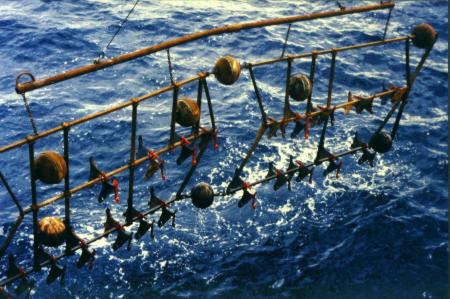The DISCOL project - a short introduction
Links

| DISCOL megafauna atlas - online
|

|
DISCOL publications |
|
|
|
Commercial deep-sea mining for manganese nodules will affect the deep-sea benthos
primarily within the track of the mined areas in a harmful and long-term way.
The removal of manganese nodules will not only destroy the hardbottom
fauna. Also the sediment clouds, created during nodule sampling by the
collector vehicle, will impact the surrounding areas.
In 1989 a long-term, large-scale, disturbance and recolonization experiment
abbreviated as DISCOL was started in the tropical southeastern Pacific Ocean
to mimic the impact of commercial mining and to achieve a better understanding
of the rate, sequence, and direction of benthic community re-establishment
after severe anthropogenic disturbance.
Close to a German manganese nodule claim, a circular area of 10.8 km2 was
selected as the DISCOL Experimental Area, abbreviated as
DEA. Its central position is located approximately 650 km southeast of
the Galapagos Islands. The water depth is between 4140 and 4160m.
In 1989 an intensive sampling program was established to obtain baseline information on
bacterial, meiofaunal, macrofaunal, and megafaunal communities in the DEA.
With a specially developed plough-harrow device, the DEA was impacted
to study the reaction of the deep-sea fauna to a disturbance to some extend
similar to a commercial deep-sea mining.

|
The "plow-harrow" was used to created a disturbance on the sea floor.
|
The disturber was towed across the DEA center 78 times on diametric courses, so that the
central parts of the DEA were more heavily disturbed than the peripheral
ones. The disturbance and the re-colonization process of the
DEA by benthic animals were studied during three additional cruises made by the
German R.V. SONNE (
table 1).
The results of the DISCOL experiment were published in
various
publications.
Table 1: Scientific Expeditions
| cruise | project | date | type of study |
| SO 61 | DISCOL 1/1 | February 2 to March 5, 1989 | Baseline Study |
| | DISCOL 1/2 | March 7, 1989 to April 3 ,1989 | 1st Post-Impact Study |
| SO 64 | DISCOL 2 | September 2 to October 2,1989 | 2nd Post-Impact Study |
| SO 77 | DISCOL 3 | January 26 to February 27, 1992 | 3rd Post-Impact Study |
| SO 106 | ECOBENT | January 1 to March 7, 1996 | 4th Post-Impact Study |
The best and most realistic opportunity to study the effects of ocean mining upon the
abyssal environment will be the monitoring of pilot mining operations planned
by industry prior to commercial mining. Environmental studies must accompany
these operations.
Large-scale experiments like DISCOL, and
Benthic
Impact
Experiments (BIEs) deployed in the Pacific and the Indian Ocean,
studying the effect of a sediment plume on the benthic community, will enhance
our knowledge about the mechanism of life in the largest and least understood
of the marine environments and will help us to minimize anthropogenic
impact on the deep-sea ecosystem.






